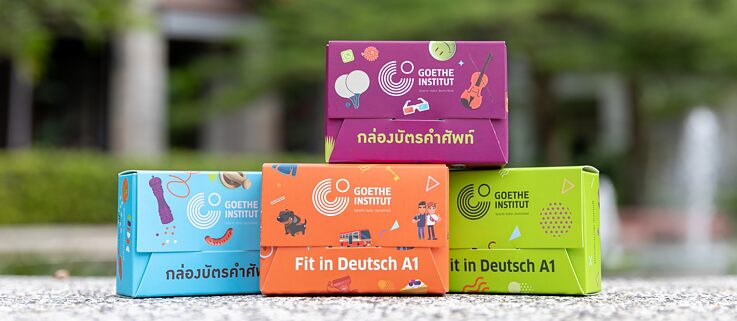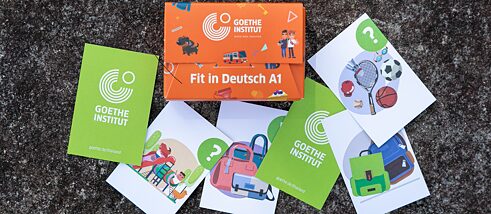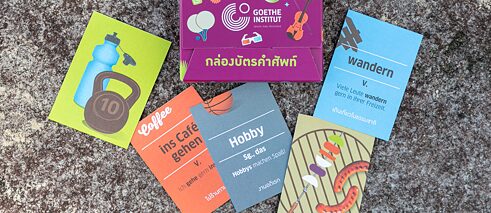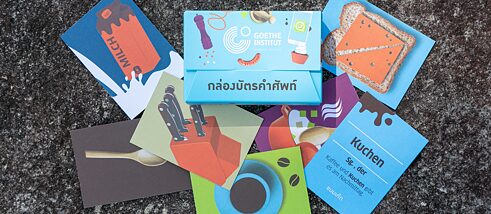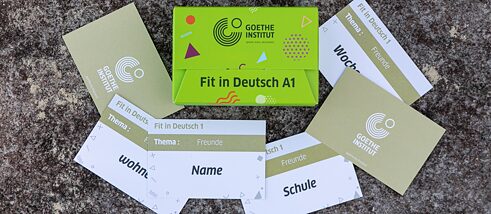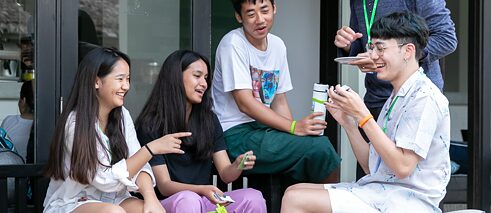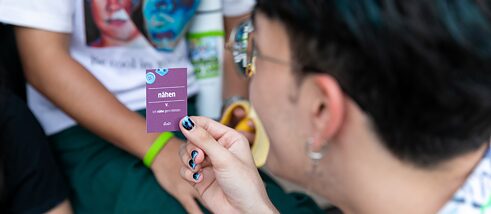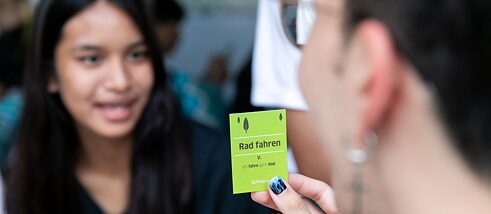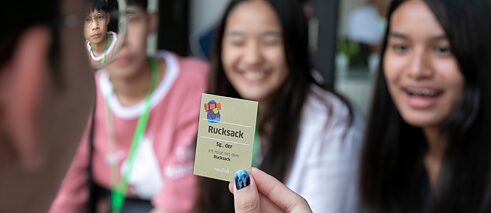By Jörg Klinner and Markus Stichel
Background
Learning with a card index has been known since the 1970s, when Sebastian Leitner presented the idea in his key work, ''Learning to Learn''. Since then there have been many learning files developed for various applications: for example mathematical formulas, historical data and vocabulary, which will play a role in this article.
Though there are many designs, the common element to all boxes is that they systematize learning. This basic principle motivated Jörg Klinner, working in an Israeli school context, to design two word boxes, which were a playful addition to the DaF-classes. Israel is considered a start-up nation, with countless applications for mobile devices are used in everyday life, it may be surprising that one did not initially go for a digital vocabulary trainer. But the decision was made consciously in favor of something haptic, in order to address learning with multiple senses and at the same time keep the workload lower than with traditional vocabulary learning, which is often still based on the idea of the Nuremberg Funnel. After Jörg Klinner transferred to his next place of employment in Bangkok, he continued the idea and also created learning boxes for the Thai context.
Description
Each word box consists of 64 cards, which structure allows cards to move backwards or remain in the front, depending on your knowledge. Both the front and the back of the vocabulary boxes can be used as a medium: the image level is an aid and stimulates association. Not only is vocabulary mentioned, but also grammatical information and the context of the words are listed, as well as a translation into the mother tongue. The design is appealing through its mixing of graphics and real images and encourage creative associations for the communicative learner.
Since the word field ''eating and drinking'' is not only part of the basic vocabulary (A1 level) of the Common Framework of Reference for Languages, but also has a concrete, real-life relationship with the learners, the relevant words were quickly found. The second word box should enable more complex language structures, but should still be familiar to the learners. This is how the cards for the topic of leisure activities were created. Only later, in the new field of work, were cards with requests and questions as well as themed cards added, which as a result of observations and exam format training have a stronger relationship to linguistic tasks.
In addition, it should be mentioned that the word boxes do not only contain German language words that learners should master at this first level of language competence, but also some vocabulary that are part of everyday vocabulary in the respective culture. There are cards such as fish sauce, chili, hot or rice for the Thai version, but also falafel, hummus or tahini as ingredients of Israeli cuisine. In order to maintain the connection to the German-speaking areas, there are cards such as sauerkraut or dumplings, some of which are an invitation to dive into the different varieties of the German language.
The superior learning purpose
As mentioned earlier, a counter product to the many digital possibilities should be created that is handy enough and therefore always at hand and that, despite the classic intention of a card index box, invites you to systematically learn many other forms of communication.
At the same time, the vocabulary trainer can be used for effective repetition and for your own learning control, in that the responsibility for your own work and learning process is passed on to the students through open assignments. This form of representation helps with memorizing and is motivating at the same time. The professional production of the word-picture sequence prevents potential errors, but is by no means complete, as blank cards created by yourself always offer opportunities for creative expansion.
Further Goals
Especially when working with adolescents, confident learning and teaching autonomy is of great importance for motivating and successful teaching. Over the years, while working with teachers in Thailand, it turned out that many of them had appreciated clear instructions on how to use the content learned in workshops (e.g. ''This app can be used well in lesson 4, section 5 in the context of regular teaching''). Nevertheless, such precise instructions are inherently a restriction of teaching autonomy, which not every teacher appreciates, which is why two scenarios were defined for the use of the word cards:
a) Extensive development of handouts for those who wish, but also;
b) Creative designs and freedom for everyone else who uses the cards to develop new ideas and who want to implement them in the course of the lesson.
However, both approaches always share a common goal: creating opportunities to speak in partner or group work. Here, point b) described above comes into play, since individual, exploratory work by the students may be explicitly desired. Teachers share their autonomy with the students and motivate them to independently create relevant language events in which they act as themselves. Skills that have already been acquired can be used here and latent knowledge within these structures through activation of already existing vocabulary which can be successfully transferred into manifested skills. At the same time, this has an effect on the form of teaching itself, since such action by the students is only possible through a radical change to learner centeredness. Here the teacher takes on an observing role, stands as a contact person on the sidelines, ready to participate on request or if necessary as an equal in the communicative speech event. The learners, on the other hand, can autonomously determine not only the topic and content, but also the pace and participants of the speaking occasion. Class observations and studies have shown the advantages of such a change in autonomy, which should not be underestimated. Speech occasions introduced as partner work can thus expand into discussions in a group, participants can switch between the thematically developing conversations in different directions, whereby the depth of the space in a class should be exploited with the aim of continuously lowering the relevance of the teaching staff until it disappears completely.
Applications in teaching and training
The conception of word boxes with corresponding word/picture cards follows two general considerations and goals: Which goals should be achieved and how is this possible?
The previous section dealt primarily with word boxes as leisure activities and ''Guten Appetit'' (note: Although this is also possible with questions & requests as well as theme cards, the boxes are basically based on a different intention), which is why such a teaching assignment should be briefly described at this point. As part of a German camp with 40 students from Thai schools with heterogenous knowledge of German, teachers from the Goethe Institute used the leisure activities box to activate the language and determine the language proficiency of the participants.
For this purpose, students (person A) each had to draw a card, look for a partner (person B) and hold the side with the motive towards person B. If they knew the motive or were able to classify it thematically, a question followed that had to be answered by person A. If person B was unable to formulate a question, person B read out loud the text facing them in German. For example: ''Weekend – I sleep late on the weekend'' If the word was still unknown, the Thai translation was read aloud. After formulating and answering a question, the roles and cards were swapped and new pairs were formed. The teachers walked through the room, listened to the conversations and assigned the speakers to one of the three language groups in the camp. Although there is nothing against the creative and independent use of the word boxes, questions & request, as well as topic cards by teacher or learners in the context of enabling speech events, these were intentionally developed for the preparation and training of the ''speaking'' skill for the Fit-A1 exam. All parts of the exam are represented by the contents of the boxes.
A card for part 1, ''Introducing yourself'' can be found in the themed card box. Here are topics and words, at the same time part 2 of the exam are portrayed, for example ''Theme/Subject ,,On vacation'', word ''Beach''. Part 3 of the ''Fit in German A1'' exam can be simulated using the Questions & Requests box. These contain cards printed on one side with motives, plus question or exclamation marks. Since the format of the examination is indicated in the course of the lesson or by the textbook used, the sequence of the ''speaking'' part is mostly known. In the past, students often copied the model sentences that were freely accessible on the Goethe Institute website to prepare for exams. However, the number of cards in relation to the word boxes is severely limited, with the result that they were known after a few rounds and students reproduced what they had already learned by heart instead of freely interacting with the language. Furthermore, copying and cutting out the word cards to simulate the examination process, caused avoidable effort. The design and feel of the boxes also represent an aesthetic added value for students. Due to relatively low production costs, it is possible to make these available to all DaF learners on request, with the result that they can be used independently outside of the class room in order to prepare for the exam together.
Outlook
As surveys done by the Goethe Institute in Thailand have shown, the use of the word boxes has already become established as part of teaching at PASCH and BKD schools throughout the Kingdom. In addition, extensive handouts were provided by Dr. Rainer E. Wicke, which will be presented to the staff as part of, a yet to be held, workshop. Further word boxes, including the topics of living, body and health as well as ''in the city'' are planned, but not yet realized.
Published by:
Jörg Klinner
Head of Language Work, Deputy Institute director with the focus on: language courses and exam organization; and implementation of language policy measures in the countries of Thailand, Laos and Cambodia
Joerg.Klinner@goethe.de
Markus Stichel
PASCH representative at the Goethe Institute Thailand with focus on: support of the school network; introduction of new DaF textbooks and organization of analogue and digital advanced training
Markus.Stichel@goethe.de
